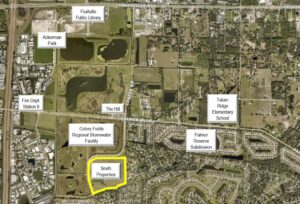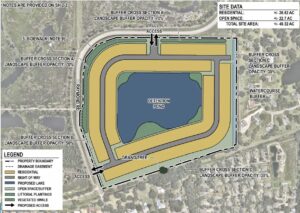In an online workshop, callers let their discontent be known.
By Johannes Werner
Original Air Date: May 15, 2024
Host: A national homebuilder wants Sarasota County to allow it to build a 170-home subdivision, on farmland right next to a prominent bird refuge and birdwatcher destination called the Celery Fields. Our news team joined a Zoom meeting yesterday, the new routine of what the county and developers now bill as a “neighborhood workshop”.
Johannes Werner: DR Horton, the Texas-based homebuilder, seems to be really intent on building on agricultural land right next to a bird sanctuary. They are willing to take steps to avoid light pollution, build a crosswalk to the Celery Fields so residents don’t have to take their car there, and build additional parking spaces at Celery Fields. They are willing to insert environmental restrictions into the deeds of the 170 homes they want to sell there. And they have even begun a dialogue with the local chapter of the Audubon Society, which has gone on the record as opposing the project altogether. All that is rather unusual for a cookie-cutter developer.
One opponent, Tom Matrullo, tried to gauge why the company picked these particular 50 acres of land. Could it be that they will charge premium for these homes near a natural attraction? Attorney Charley Bailey, who represents DR Horton, was evasive.
Tom Matrullo: Why did you choose these 26 acres to build 170 homes on? There is obviously much more property lying around Sarasota County to which you could have chosen to design a neighborhood, without all the constraints that you’ve been dealing with. And as you know we visited you a couple of times, and the extent to which you have tried to comply and bend it over backwards and  create buffers, all in effort to kind of try to make this 170 homes disappear. Alas, you won’t. They’re still going to be there.
create buffers, all in effort to kind of try to make this 170 homes disappear. Alas, you won’t. They’re still going to be there.
So I guess the first question is why these 26 acres in Sarasota County?
Charley Bailey: In short, it’s again, it’s 49 plus acres, number one. Number two, it’s within the county’s urban service boundary. Number three, it’s devoid of any native habitat; It’s agricultural land, so it is already developed. It’s not developed in the sense there are tons of infrastructure and vertical improvements within it, but it is developed land, it’s devoid of any protected native habitat. So, from a land planning standpoint and development standpoint, it is a very, very desirable location for developable land.
TM: Okay, may I just follow up then with the second part of the question. The value of having the location near a fabulous amenity, like the Celery Fields, clearly has to be part of why Horton wants to be here. They are allegedly going to be asking quite a price for these homes, attached homes at $500,000. That’s not chicken feed.
CB: It’s detached, single family detached. Attached, the term you use in land use parlance is like a townhome. We’re not doing townhomes, we’re doing single family detached.
TM: Oh, so there’ll be space between the homes, is that what you’re saying?
CB: It’s called side yards, yes sir.
TM: Ah, okay. Sorry, I misheard that when it was mentioned earlier. But obviously, the question has to do with the benefit accruing to the business part of this plan because you’re near the amenity. Could you speak to that?
CB: Yeah, I’m not going to beat around the bush or I’m not sure what the phrase you use … I’ll hit it directly. This is a desirable location. It’s in the urban service area, it has infrastructure, it’s proximate to job opportunities. We do like the fact that it is proximate to the celery fields. I used to live in downtown Sarasota, the fact that I could walk to Laurel Park or I could walk to Payne Park was a good thing. So yes, that is a nice amenity, and we’re trying to certainly embrace that.
JW: Matrullo is a board member of WSLR.
Another caller expressed concern about the new homeowners’ cats, which do not have a good track record of co-existing with birds. Could there be restrictions on letting cats roam outdoors? Lawyer Bailey said he did not know.
Caller 1: Can something be put in there for like no outdoor cats, and then how would you enforce that? So there’s lifestyle issues that, I mean, traffic is a lifestyle issue, but also how people live with light and their pets is also a lifestyle impact on the Celery Fields. So how do you mitigate something like that? I don’t think it’s possible. That’s just a comment.
CB: Yeah, I don’t know. I mean, we’ve had some projects we have installed like hot wire fences to keep, you know, wild hogs out, but I know that domestic animals interfacing with wildlife, but … I don’t know.
C1: Yeah, it seems like more people means more cats eating birds, and that would be significant in this location.
CB: For the record, I’m a dog guy. Indoor dog guy. [laughs] But I’m with you. I do understand what you’re saying. I appreciate it.
JW: Finally, another caller asked whether DR Horton is taking into consideration possible soil contamination from years of agriculture. A nearby planned development has stumbled over an arsenic issue. Bailey said the developer is not required to take the problem at this particular property into account, but that it’s part of routine due diligence.
CB: Yeah, I mean, celery, we got blending a couple different issues. Celery Fields, because of its heavy, heavy, heavy agricultural use for decades, it has contaminated soil, which is now piled up in the Celery Fields, which is now beautifully and thankfully an amenity that attracts nature. I’m familiar with Worthington. I know where that is. I’m not sure every project you’ve got a pencil about whether you have enough fill on site or have to bring fill in. At this point, I’m not sure that we’ve got all the information—
Caller 2: There was a whole toxic situation with the environmental. You’re not familiar with that?
CB: Well, with regard to what parcel?
C2: The whole Worthington development on Palmer.
CB: Well, we’re here to, yeah, I’m familiar with that, but in terms of contamination, there was floodplain compensation that was required, but we’re here actually to discuss this project. Do you have concerns that we have contaminated soil or floodplain issues?
C2: I mean, I’m just saying. It would be prudent for the developers to check and see if he’s got arsenic or tamoxifene on the product. I’m not saying there is.
CB: Sure, sure.
C2: But you don’t, that’s a question mark, right?
CB: Yeah, yeah. I don’t know, but those are the types of things that are done during due diligence reporting with buys property.
JW: Most of the callers wanted to be on the record as opposing the development.
This was the second of two neighborhood workshops. The company has filed its plans with the Sarasota County Development Review Committee. Next will be a review by the county planning commission, which will then make a recommendation to the Sarasota County Commission. No dates have been set for either.
For WSLR News, this is Johannes Werner.
WSLR News aims to keep the local community informed with our 1/2 hour local news show, quarterly newspaper and social media feeds. The local news broadcast airs on Wednesdays and Fridays at 6pm.